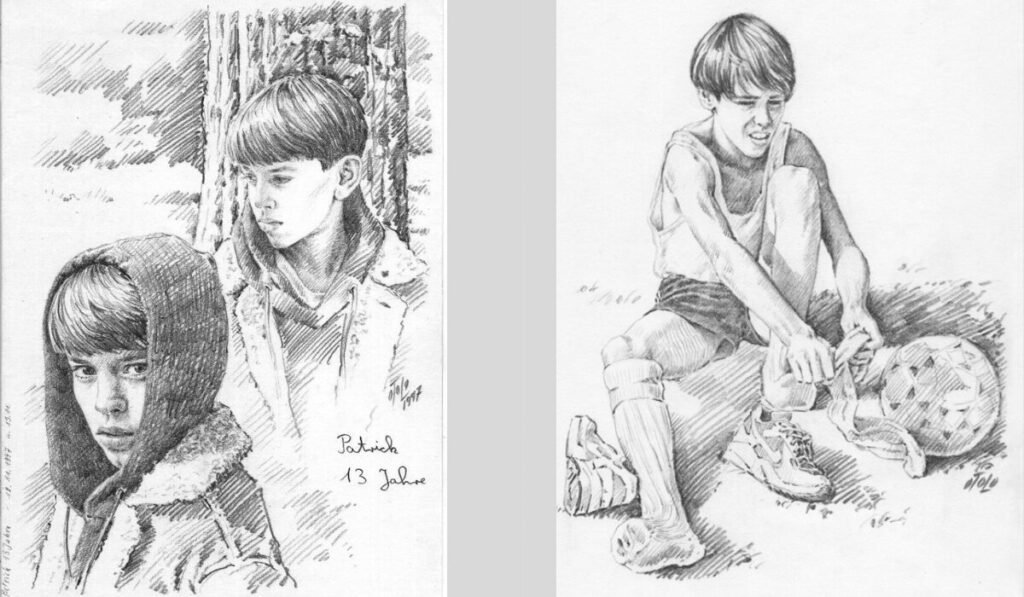Otto Lohmüller Patrick Art is an endless ocean of views, each artist bringing a unique lens through which we view the world. Otto Lohmüller, a German artist regarded for his figurative works, offers this sort of perspective, in particular through his portrayals of adolescent adult males. His work is well-known and critiqued for its technical prowess and emotional layers. Among his creations, the routine depiction of Patrick has sparked intrigue and debate. This dives into the sector of Otto Lohmüller and his muse, exploring their effect on artwork and society.
Meet Otto Lohmüller Patrick
Otto Lohmüller is famed for his meticulous attention to detail and the emotive intensity captured in his art. Born in Germany, Lohmüller’s fascination with human shape, particularly that of adolescent boys, sets him apart in the art world. He approaches his topics with both a sensible and idealistic lens, creating a sensitive interplay between innocence and experience.
Lohmüller’s photos frequently feature his subjects in classical poses, harking back to Renaissance artwork. This stylistic choice lends a timeless high quality to his work and lets viewers explore the nuanced expressions and posture of the subjects he paints. Collectors and art lovers alike are drawn to his ability to seize fleeting moments of teenagers.
The Artistic Journey of Otto Lohmüller
Lohmüller’s artistic endeavors started at a younger age. His early exposure to classical art sparked a hobby in human anatomy and its expressive competencies. By analyzing the works of top-notch masters like Michelangelo and Raphael, Lohmüller honed his technique, eventually developing a fashion uniquely his own.
Over time, his work has advanced from easy sketches to extra complex compositions. The introduction of the discern “Patrick” marked a significant phase in his career, drawing both admiration and criticism. Yet, Lohmüller stays steadfast in his pursuit of taking pictures of human emotion and shape, using his artwork to tell memories otherwise left unstated.
Critical Themes in Lohmüller’s Work
Through Lohmüller’s art, numerous issues emerge, reflecting his private stories and broader societal troubles. His focus on formative years speaks to the temporary nature of youth, a length of both vulnerability and resilience. By portraying his subjects in relaxed, unguarded poses, he invites visitors to reflect on their own trips through childhood.
The exploration of identification is every other habitual subject matter in Lohmüller’s work. His subjects, particularly Patrick, are depicted in numerous contexts, each piece offering insights into unique aspects of identity. This theme resonates with audiences who discover parallels between the topics’ introspection and their search for self-information.
Lohmüller’s paintings additionally grapple with the balance between realism and idealism. Though grounded in reality, his pictures convey an airy exceptionality that elevates them beyond mere representation. This duality challenges viewers to rethink their perceptions of splendor and truth.
Patrick’s Place in Lohmüller’s Art
Among Lohmüller’s works of art, the recurring photo of Patrick stands proud. Patrick is more significant than just a topic; he is an image of the artist’s exploration of youngsters and identification. In each portrayal, Patrick embodies a different issue of childhood, from carefree innocence to contemplative maturity.
The name “Patrick” has become synonymous with Lohmüller’s work, catching the eye of artwork critics and fanatics alike. While a few admire the smooth portrayal, others question the intentions behind the continued recognition of a novel parent. Despite differing reviews, Patrick remains indispensable to Lohmüller’s artistic narrative.
A Collector’s Perspective
Maria, an artwork collector, first encountered Lohmüller’s work at an exhibition in Munich. Initially, she perceived the artwork as simplistic, but she found layers of meaning upon closer examination. The subjects’ subtle expressions and body language found narratives past the canvas.
Maria’s enjoyment highlights the depth of Lohmüller’s work, wherein initial impressions give way to a richer knowledge. For creditors, proudly owning a Lohmüller piece is an approach to conducting an ongoing dialogue with the artwork, each viewing presenting new insights and interpretations.
Artistic Skill and Emotional Depth
One can not speak of Otto Lohmüller without acknowledging his technical skill. His mastery of anatomy and composition allows him to create practical representations that resonate with visitors. The precision with which he captures human shape is a testament to years of willpower and practice.
Yet technical talent alone does not define Lohmüller’s fulfillment. It is his potential to imbue each piece with an emotional depth that sets him apart. Through diffused brushstrokes and nuanced shading, he conveys the complexities of human emotion, drawing visitors into the subjects’ internal worlds.
Controversy and Critique
Despite his acclaim, Lohmüller’s paintings have not been without controversy. His cognizance of adolescent men, specifically the recurring picture of Patrick, has led a few critics to impeach the motivations behind his artwork. Concerns about the portrayal of adolescents and its implications have sparked debate within the art community.
Lohmüller’s reaction to grievance displays his commitment to creative expression. He views art as a medium for exploring complicated topics and challenging societal norms. By frightening dialogue, Lohmüller hopes to inspire deeper mirrored images of the subjects he portrays.
Lohmüller’s Influence on Surrealism
Lohmüller’s effect extends beyond his frame of labor. His potential to blend technical precision with emotional resonance has inspired many modern-day artists, especially those within the surrealist movement. By pushing the limits of traditional portraiture, Lohmüller paved the way for brand-new interpretations of human shape.
Artists like Salvador Dalí and René Magritte have drawn inspiration from Lohmüller’s paintings, integrating elements of his fashion into their own. Through those effects, Lohmüller’s legacy continues to shape the evolution of modern artwork, bridging the gap between realism and surrealism.
Balancing Realism and Idealism
The pressure on authenticity and optimism is a characterizing component of Lohmüller’s specialty. While his pictures are truthfully grounded, they have an ethereal quality that rises above simple portrayal. This communication moves watchers to reexamine their impression of truth and excellence.
By juxtaposing practical information with idealized factors, Lohmüller creates a dialogue between the tangible and the imagined. This stability invites viewers to discover the boundaries of fact and fable, prompting introspection on the character of life.
Innocence and Experience
Lohmüller’s exploration of innocence and enjoyment is valuable in his paintings. His subjects, regularly depicted in relaxed poses, embody the duality of adolescence—a time of both vulnerability and resilience. Through those portrayals, Lohmüller captures the essence of teenagers, inviting visitors to reflect on their own trips.
This theme resonates with audiences who find parallels between the subjects’ introspection and their search for identity. Lohmüller’s paintings remind us of children’s temporary nature and the enduring effect of formative reports.
Concluding Thoughts on Otto Lohmüller’s Artistry
Otto Lohmüller Patrick’s contributions to the art international are full-size. His specific method of portraying the human form, mainly through the habitual photo of Patrick, gives a glimpse into the sensitive balance between realism and idealism. While his work has sparked controversy, it has inspired limitless artists and collectors.
For those interested in exploring Lohmüller’s artistry, enticing along with his paintings gives a window into the complexities of human emotion and identity. By immersing themselves in his pics, visitors can discover layers of which means and connect with the time-honored subject matters that outline Lohmüller’s legacy.
Otto Lohmüller’s artwork, with its technical precision and emotional intensity, is a testament to the long-lasting electricity of creative expression in shooting human enjoyment. His paintings continue to provoke ideas and inspire talk, whether through admiration or critique, ensuring they remain in the annals of artwork records.

